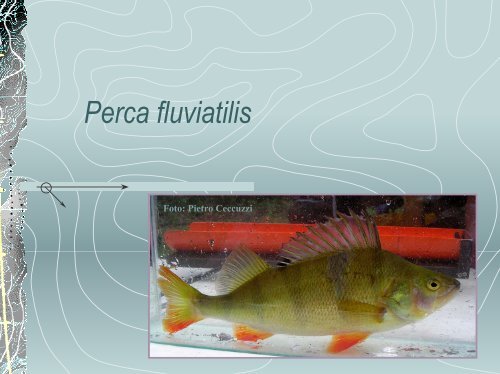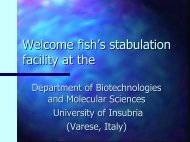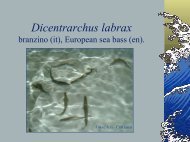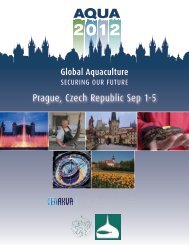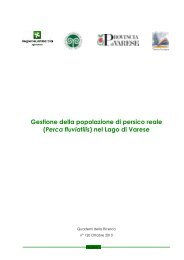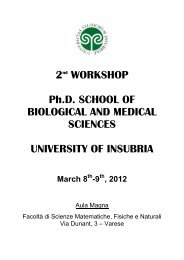Perca fluviatilis - DBSM
Perca fluviatilis - DBSM
Perca fluviatilis - DBSM
- No tags were found...
Create successful ePaper yourself
Turn your PDF publications into a flip-book with our unique Google optimized e-Paper software.
<strong>Perca</strong> <strong>fluviatilis</strong>Foto: Pietro Ceccuzzi
Taxonomy (from NCBI)Kingdom: AnimaliaPhylum: ChordataSubphylum: VertebrataSuperclass: Osteichthyes -- bony fishes,Class: Actinopterygii spiny rayed fishesSubclass: Neopterygii -- neopterygiansInfraclass: TeleosteiSuperorder: AcanthopterygiiOrder: PerciformesSuborder: PercoideiFamily: PercidaeGenus: <strong>Perca</strong> Linnaeus, 1758 -- yellow perchesSpecies: <strong>Perca</strong> <strong>fluviatilis</strong> Linnaeus, 1758
Morphological featuresMax. length: 51.0 cm; Max. weight: 4,5 g; Max. reported age: 22 years.Morphology: Greenish-yellow body with scales, with 5-9 darker transversalbands on sides. Rayed spines: 14-20 dorsal, with 13-16 soft rays; 7-10 analsoft rays. The first dorsal fin is gray and greater, second dorsal and pectoralyellow, others fins reddish. Skeleton with 39-42 vertebrae.Foto: Pietro Ceccuzzi2 cm
HabitatThe Baltic sea near StockholmSlow flowing rivers, deep lakes andponds, but also common in the BalticSea. Usually found near submersedobstacles. Temperature: 10 – 22°C.Foto: A.G. CattaneoGeographical distribution: Europe andSiberia (native). Originally absent inLago Maggiore near Varese, ItalyItaly, Spain, Greece and Great Britain, hasbeen successfully introduced since XVIII century (from 1860 in Italy). Largelycultured for commercial purposals also in the Southern hemisphere (Australia).Foto: A.G. Cattaneo
Feeding and BehaviourPredator:• Larval stage: zooplankton.• Juvenile and adult life: zooplankton, zoobenthos and nekton.Can be predated by Anguilla anguilla, Sander lucioperca andother fishes.Swimming type: carangiform, by movements of body and ofthe caudal fin. Speed: 0,5-1 m/h.
ReproductionReproduction: dioecism, external fertilization, polyandria.Spawning: in open waters, once a year in spring (autumn in theSouthernFoto: Pietro Ceccuzzihemisphere).Eggs: in jellymatrix and inribbons 1 m longand bound to asubstratum.
Early development: fertilized eggsEggs: white,spherical,embeddedin a jelly andwhitishmatrix.(The pictureshows eggs14 hours afterfertilization).Foto: Pietro Ceccuzzi
Early development: egg with embryoEggs hatch in 8–16days after deposition.Larvae develop in 37days at 13°C.Dry weight:• 164 µg at hatching• 11600 µg atmetamorphosis.Foto: Pietro Ceccuzzi
Young adultsYoungerindividuals aregray, withtraversal bands onsides darker thanin adult.Lateral shape ismore elongated.Sex, determinedsince birth, can beidentified at 1+.1 cmFoto: Pietro Ceccuzzi
Fully developed adultFoto: Pietro CeccuzziBody symmetric,cross sectioncompressed,lateral shapeshort and deep.Head is convex,mouth terminal.Age range:2-3 y (M)3-5 y (F)(2 cm)
Links and sourcesNCBIFish BaseITIS, Integrated Taxonomy Information System


